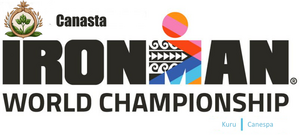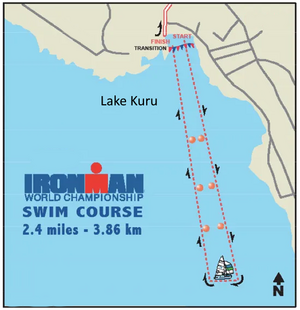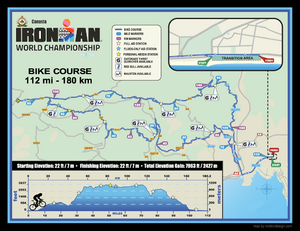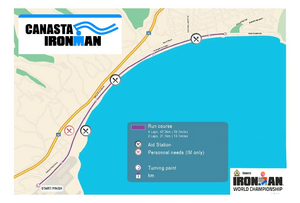Ironman World Championship of Canespa: Difference between revisions
PotatoLover (talk | contribs) mNo edit summary |
PotatoLover (talk | contribs) mNo edit summary |
||
| (7 intermediate revisions by the same user not shown) | |||
| Line 1: | Line 1: | ||
{{Infobox racecourse|Name=Ironman World Championship of Canespa|logo=Kuru Championship Logo.png|Location=[[Kuru]], [[Papa]], Canespa|Owner=Canasta Ironman CO.|Opened=August 27th 1984|RaceType=Ironman, Triathlon|Website=www.CanastaIronman.com}} | {{Infobox racecourse|Name=Ironman World Championship of Canespa|logo=Kuru Championship Logo.png|Location=[[Kuru]], [[Papa]], Canespa|Owner=Canasta Ironman CO.|Opened=August 27th 1984|RaceType=Ironman, Triathlon|Website=www.CanastaIronman.com}} | ||
The Ironman World Championship of Canespa or the Lake Kuru Ironman is an annually held event in Kuru, Canespa, being the most prestigious Ironman race on the globe. Founded in 1984 by Pachacuti and Chasca Ocllo along with the Canasta Company, the triathlon was a first in both size and intensity. The Ironman consists of a 2.4-mile (3.9 km) swim, a 112-mile (180.2 km) bicycle ride and a marathon 26.22-mile (42.2 km) run completed in that order, a total of 140.6 miles (226.3 km). It is widely considered one of the most difficult one-day sporting events in the world, with less then 100,000 people even completing the race each year worldwide. Only around 2000 people qualify for the Ironman World Championship as you need to receive a Kuru slot from various different means. | The [[Ironman World Championship of Canespa]] or the Lake Kuru Ironman is an annually held event in [[Kuru]], [[Canespa]], being the most prestigious [[:en:Ironman_Triathlon|Ironman]] race on the globe. Founded in 1984 by Pachacuti and Chasca Ocllo along with the [[Canasta Company]], the triathlon was a first in both size and intensity. The [[:en:Ironman_Triathlon|Ironman]] consists of a 2.4-mile (3.9 km) swim, a 112-mile (180.2 km) bicycle ride and a marathon 26.22-mile (42.2 km) run completed in that order, a total of 140.6 miles (226.3 km). It is widely considered one of the most difficult one-day sporting events in the world, with less then 100,000 people even completing the race each year worldwide. Only around 2000 people qualify for the [[Ironman World Championship of Canespa|Ironman World Championship]] as you need to receive a Kuru slot from various different means. | ||
[[File:Canasta Ironman.png|left|frameless]] | [[File:Canasta Ironman.png|left|frameless]] | ||
The idea behind the Ironman was first thought up by Pachacuti and Chasca Ocllo in 1982. The couple were both avid triathletes who had moved to Lake Kuru from their home in Extranjero. The idea was prompted after Pachacuti and other triathletes got into an argument over if runners or swimmers were more fit. During the argument Canespan Naval Commander Atahualpa Coyllur pointed out a Levantine Times Union article which had stated that a bicyclist from Burgundie had the highest recorded oxygen intake of any human. As such Pachacuti and a few others including his wife Chasca came up with the first Ironman distance triathlon. They stated that whoever finished the race first would be known as the "Iron Man" and as such the race was born. With the help of some higher ups at the Canasta Company the first Ironman race was sanctioned and held at Lake Kuru on August 27th 1984. The first race only had 54 participants and only 13 finished the race with Cusi Caupolicán and Lautaro Yatiri being the first two to receive the title of Ironman. Following the first few races being held in Kuru, the distance grew in popularity and started spreading worldwide. | The idea behind the [[:en:Ironman_Triathlon|Ironman]] was first thought up by Pachacuti and Chasca Ocllo in 1982. The couple were both avid triathletes who had moved to [[Lake Kuru]] from their home in Extranjero. The idea was prompted after Pachacuti and other triathletes got into an argument over if runners or swimmers were more fit. During the argument [[Canespa|Canespan]] Naval Commander Atahualpa Coyllur pointed out a [[Levantine Times Union Corporation|Levantine Times Union]] article which had stated that a bicyclist from [[Burgundie]] had the highest recorded oxygen intake of any human. As such Pachacuti and a few others including his wife Chasca came up with the first [[:en:Ironman_Triathlon|Ironman]] distance triathlon. They stated that whoever finished the race first would be known as the "Iron Man" and as such the race was born. With the help of some higher ups at the [[Canasta Company]] the first [[:en:Ironman_Triathlon|Ironman]] race was sanctioned and held at [[Lake Kuru]] on August 27th 1984. The first race only had 54 participants and only 13 finished the race with Cusi Caupolicán and Lautaro Yatiri being the first two to receive the title of [[:en:Ironman_Triathlon|Ironman]]. Following the first few races being held in [[Kuru]], the distance grew in popularity and started spreading worldwide. | ||
== Qualification == | == Qualification == | ||
There are different ways to qualify for and receive a Kuru slot. The most popular and common way to earn a slot is to compete in one of the six continental Ironman Championships. Those being Ironman Kiro-Borea Championships Kiravia, Ironman Crona Championships | There are different ways to qualify for and receive a Kuru slot. The most popular and common way to earn a slot is to compete in one of the six continental Ironman Championships. Those being [[Ironman Kiro-Borea Championships Kiravia]], [[Ironman Crona Championships Tierrador]], [[Ironman Australis Championships Timbia]], [[Ironman Sarpedon Championships Caphiria]], [[Ironman Levantia Championships Burgundie]], or [[Ironman Audonia Championships Syliria]]. Each race has no specific number of qualifiers who get a Kuru slot but instead the number of qualifying slots per race depends on the number of people in each race and age group. With there being a minimum slot of one for each age group. Age groups start at 18-24 and go up in 5 year increments up to 85+ with the number of slots in each age group varies depending on the average performance of said age group with a new number of slots being chosen each year. Another way to earn a Kuru slot is by entering a drawing and or bidding for your slot. These options only make up around 10% of the qualifying slots but are popular due to the lack of a prior performance being needed. The last method of getting into the [[:en:Ironman_Triathlon|Ironman]] is by receiving a special entry. Athletes who are unable to qualify through the above methods may be given a special entry into the World Championship under certain criteria like being a professional athlete, humanitarian reasons, medical hardship and etc. | ||
== Route == | == Route == | ||
[[File:Ironman2010SwimMap.png|left|frameless|Map of Swim Route]] | |||
=== Swimming === | === Swimming === | ||
[[ | The swimming portion starts the [[:en:Ironman_Triathlon|Ironman]] and goes straight out into the lake with a turn at the 1.2 mile (1.93 km) mark. It begins at 7:00 am, and after 2 hours and 20 minutes and participants still on the swim will be disqualified. Upon swimming back participants must go to the transition area to prepare for their bike ride. Various members from the coast guard along with lifeguards on paddle boats will ensure safety along the entire 2.4 mile swim. | ||
| Line 20: | Line 19: | ||
[[File:Ironman bike route.png|frameless|right]] | |||
=== Biking === | === Biking === | ||
[[ | The biking portion of the [[:en:Ironman_Triathlon|Ironman]] begins right after the swim portion and the transition phase. The entire biking portion is 1112-miles (180.2 km). It starts from an elevation 7 meters above the lake and climbs to a peak of 2427 meters above the lake before looping and going back to the same transition area. Its the longest portion of the [[:en:Ironman_Triathlon|Ironman]], making up just less then 80% of the Triathlon. All triathletes have until 10 hours after the start of their swim to complete the biking portion of the race or they will be disqualified and removed from the race. | ||
| Line 30: | Line 29: | ||
[[File:Ironman Run rouite.webp|left|frameless]] | |||
=== Running === | === Running === | ||
The running portion of the [[:en:Ironman_Triathlon|Ironman]] is the final phase following the biking and second transition phase. It totals 26.22 miles (42.2 km) and has four total laps. Participants have until 16 hours after the start of their swim to finish the running portion of the [[:en:Ironman_Triathlon|Ironman]]. Upon finishing the running portion you ring a gong to signify the end of your race. Racers who are set to receive awards or cash prizes will be notified following the races end. | |||
== Award Ceremony == | |||
The Official Awards Ceremony is held on August 28th every year following the end of the Triathlon. There are a total of 650,000 [[Taler|Talers]] in prizes as well as multiple trophies and awards made out of rare earth minerals. The awards ceremony is from 3pm to 10pm with each age group getting unique awards and cash prizes. Including 50,000 dollars for the top finishing male and female. | |||
[[Category:Canespa]] | |||
[[Category:Sports]] | |||
Latest revision as of 19:40, 15 July 2024
 | |
| Location | Kuru, Papa, Canespa |
|---|---|
| Owned by | Canasta Ironman CO. |
| Date opened | August 27th 1984 |
| Race type | Ironman, Triathlon |
| Official website | |
The Ironman World Championship of Canespa or the Lake Kuru Ironman is an annually held event in Kuru, Canespa, being the most prestigious Ironman race on the globe. Founded in 1984 by Pachacuti and Chasca Ocllo along with the Canasta Company, the triathlon was a first in both size and intensity. The Ironman consists of a 2.4-mile (3.9 km) swim, a 112-mile (180.2 km) bicycle ride and a marathon 26.22-mile (42.2 km) run completed in that order, a total of 140.6 miles (226.3 km). It is widely considered one of the most difficult one-day sporting events in the world, with less then 100,000 people even completing the race each year worldwide. Only around 2000 people qualify for the Ironman World Championship as you need to receive a Kuru slot from various different means.

The idea behind the Ironman was first thought up by Pachacuti and Chasca Ocllo in 1982. The couple were both avid triathletes who had moved to Lake Kuru from their home in Extranjero. The idea was prompted after Pachacuti and other triathletes got into an argument over if runners or swimmers were more fit. During the argument Canespan Naval Commander Atahualpa Coyllur pointed out a Levantine Times Union article which had stated that a bicyclist from Burgundie had the highest recorded oxygen intake of any human. As such Pachacuti and a few others including his wife Chasca came up with the first Ironman distance triathlon. They stated that whoever finished the race first would be known as the "Iron Man" and as such the race was born. With the help of some higher ups at the Canasta Company the first Ironman race was sanctioned and held at Lake Kuru on August 27th 1984. The first race only had 54 participants and only 13 finished the race with Cusi Caupolicán and Lautaro Yatiri being the first two to receive the title of Ironman. Following the first few races being held in Kuru, the distance grew in popularity and started spreading worldwide.
Qualification
There are different ways to qualify for and receive a Kuru slot. The most popular and common way to earn a slot is to compete in one of the six continental Ironman Championships. Those being Ironman Kiro-Borea Championships Kiravia, Ironman Crona Championships Tierrador, Ironman Australis Championships Timbia, Ironman Sarpedon Championships Caphiria, Ironman Levantia Championships Burgundie, or Ironman Audonia Championships Syliria. Each race has no specific number of qualifiers who get a Kuru slot but instead the number of qualifying slots per race depends on the number of people in each race and age group. With there being a minimum slot of one for each age group. Age groups start at 18-24 and go up in 5 year increments up to 85+ with the number of slots in each age group varies depending on the average performance of said age group with a new number of slots being chosen each year. Another way to earn a Kuru slot is by entering a drawing and or bidding for your slot. These options only make up around 10% of the qualifying slots but are popular due to the lack of a prior performance being needed. The last method of getting into the Ironman is by receiving a special entry. Athletes who are unable to qualify through the above methods may be given a special entry into the World Championship under certain criteria like being a professional athlete, humanitarian reasons, medical hardship and etc.
Route

Swimming
The swimming portion starts the Ironman and goes straight out into the lake with a turn at the 1.2 mile (1.93 km) mark. It begins at 7:00 am, and after 2 hours and 20 minutes and participants still on the swim will be disqualified. Upon swimming back participants must go to the transition area to prepare for their bike ride. Various members from the coast guard along with lifeguards on paddle boats will ensure safety along the entire 2.4 mile swim.

Biking
The biking portion of the Ironman begins right after the swim portion and the transition phase. The entire biking portion is 1112-miles (180.2 km). It starts from an elevation 7 meters above the lake and climbs to a peak of 2427 meters above the lake before looping and going back to the same transition area. Its the longest portion of the Ironman, making up just less then 80% of the Triathlon. All triathletes have until 10 hours after the start of their swim to complete the biking portion of the race or they will be disqualified and removed from the race.

Running
The running portion of the Ironman is the final phase following the biking and second transition phase. It totals 26.22 miles (42.2 km) and has four total laps. Participants have until 16 hours after the start of their swim to finish the running portion of the Ironman. Upon finishing the running portion you ring a gong to signify the end of your race. Racers who are set to receive awards or cash prizes will be notified following the races end.
Award Ceremony
The Official Awards Ceremony is held on August 28th every year following the end of the Triathlon. There are a total of 650,000 Talers in prizes as well as multiple trophies and awards made out of rare earth minerals. The awards ceremony is from 3pm to 10pm with each age group getting unique awards and cash prizes. Including 50,000 dollars for the top finishing male and female.